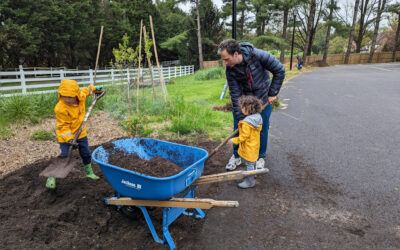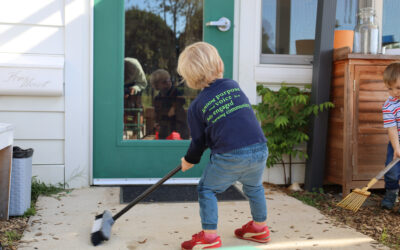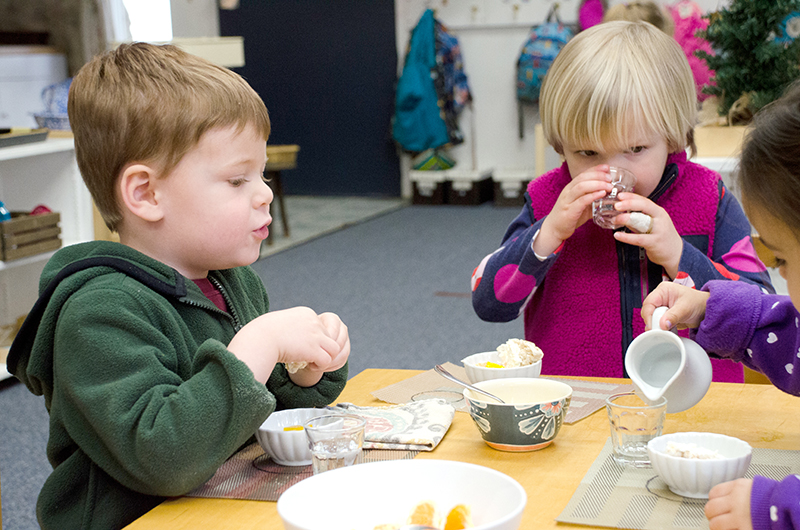
We all know that young children thrive on consistency and routine. Dr. Montessori discovered that children from ages one to four are actually in a “sensitive period” for order. This means that not only do they crave consistency from their environment and schedule, but that toddlers are particularly attuned to developing an internal sense of order at this age, if given opportunities to develop this skill.
For this reason, Montessori environments – both at school and in the home – are carefully prepared so that every item has a place. (I have previously posted about setting up Montessori spaces in the home – the bedroom and the bathroom – and am currently working on a piece about the kitchen.) But while it’s fairly easy to create physical places for things, creating a sense of order throughout the day is far more difficult. Young children have a strong need to feel in control and yet so much of what happens during the day is determined by others. Plus, toddlers can’t yet grasp the concept of time – today, tomorrow and yesterday – because the part of the brain that is able to plan ahead and make predictions about the future is still developing.
Creating a few simple routines at home can help your toddler practice making simple predictions, as well as understand concepts such as “before and after.” A consistent routine can (sometimes) eliminate power struggles because your child feels more control over what is happening. A routine is especially helpful during difficult times of day, such as at bedtime or when getting ready for school in the morning.
I’ve collected a few tips good from the experts:
Include preparation for transitions in the routine. For example, say, “We have 10 minutes left before we start getting ready for bed. Since toddlers can’t read a clock, try setting a timer. When the timer goes off, it’s time to start the bedtime routine.
Include opportunities for (limited) choice. Toddlers like to feel in control. You can create the illusion of choice, such as “Are you going to wear the blue shirt or the red shirt?” By putting clothes where your child can access them, this also allows for greater control (aka, independence!) over the process.

Get silly! Even with consistent routines, toddlers will still test the limits. Recently, my daughter, Lila, started to resist getting dressed in the morning. Now my husband helps her “hop” into her clothes and then challenges her to see how high she can jump on the trampoline in her “jumping pants.” Hey, whatever works! And when this stops working, we’ll have to change it up again.
Try creating a picture schedule for your child. During her transition to a Montessori toddler program, Lila began to ask every morning, “Is there school today?” So we created a photo schedule that would show what was going to happen each day of the week. It allows us to discuss the next day’s schedule and Lila can refer to the schedule when she wants to know what is going to happen next. I have found several websites that offer free printables for daily routines, such as these on pricelessparenting.com. Older children may enjoy drawing pictures for their charts.
 Practice routines with activities that are fun, as well as chores. Routines aren’t only for things kids have to do. Lila enjoys making coffee with her daddy on Saturday mornings. She loves being the taskmaster: “Step 1: Grind the beans!”
Practice routines with activities that are fun, as well as chores. Routines aren’t only for things kids have to do. Lila enjoys making coffee with her daddy on Saturday mornings. She loves being the taskmaster: “Step 1: Grind the beans!”
Keep your daily schedule as predictable as possible. Your child will take comfort in knowing that she goes to school in the morning, comes home for lunch and a nap, and then has playtime in the afternoon. For this reason, we chose to enroll Lila in a Montessori toddler program five mornings a week. Her adjustment to school still included separation anxiety, but thanks to the consistent schedule, Lila quickly began to learn what to expect each day, and this knowledge provided some comfort. In a matter of a few weeks, Lila began to see school as a joyful place where she belonged; now she walks through that classroom door without looking back!
Stay flexible. Of course, children do need to learn how be flexible and deal with minor changes. But that’s why we offer children a predictable routine as a foundation–so they can rise to the occasion to handle big changes when they need to. If there is an interruption to the routine, you can tell your child, “I know we usually do ___, but today we are going to do ___ because (reason). Tomorrow we will go back to our usual schedule.”
It is never too late to start a routine. You can introduce a new routine by saying, “The way that we have been doing things has not been working. We are going to try something new. Here is our new schedule.” Give the new routine some time before making adjustments. Your toddler will resist at first; consistency is key!
To read more about the benefits of setting up routines for your toddler, check out this article by Aha! Parenting.
If you would like to learn more about our Toddler program, please click here.




